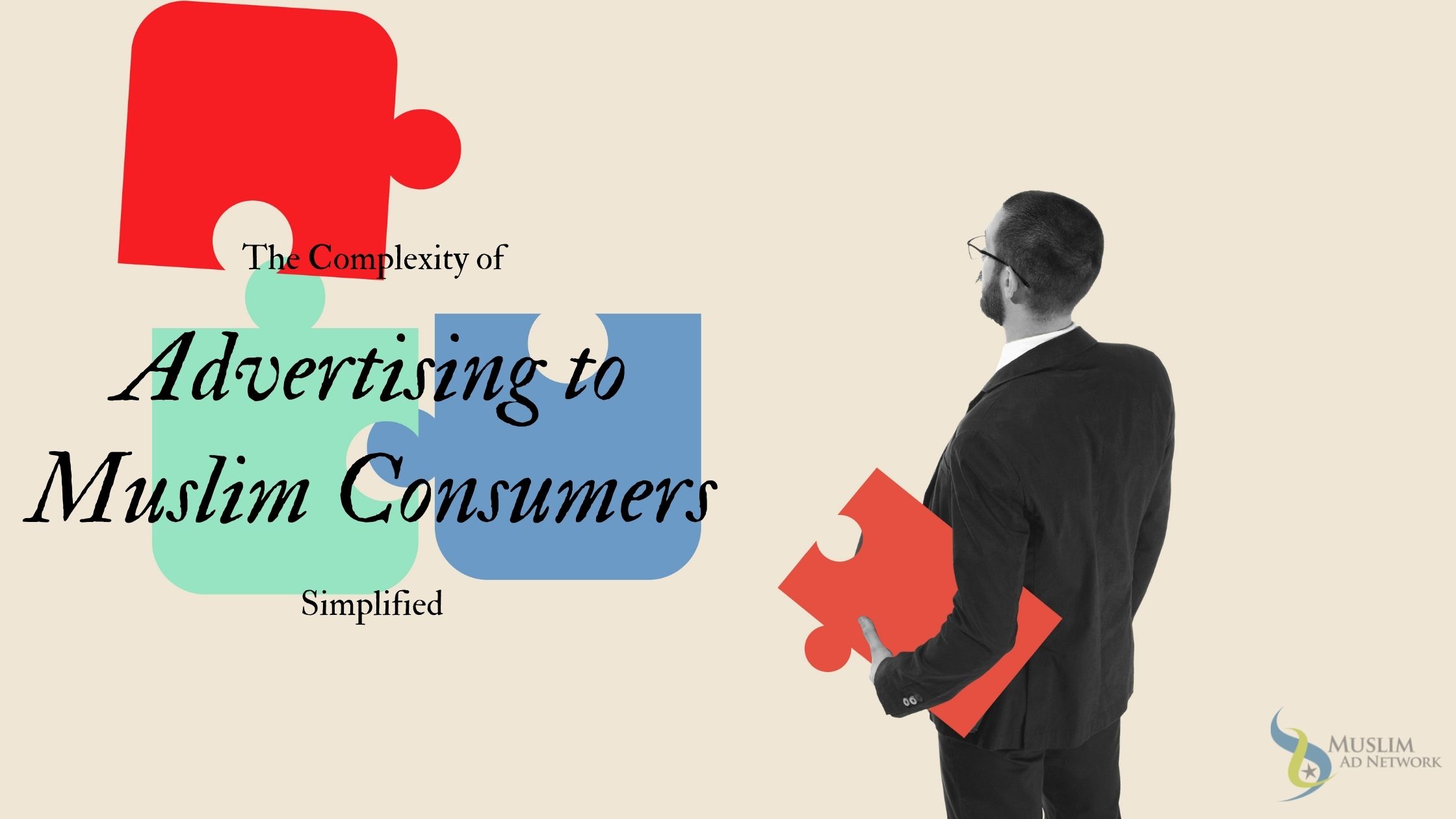
Advertising to Muslim consumers is already tough enough due to advertising companies like Google and Facebook not allowing brands to target by religion. However, there is another degree of complexity that most advertisers come up against. This complexity is due to:
- levels of religiosity
- ethnicity and culture
- demographics
Muslims are not one big homogeneous group of people. Yes, Islamic values unite Muslims across the globe but there are also many aspects that make them unique.
This article has been purposely simplified in order to help the reader understand the basics of navigating the complex world of Muslim consumer marketing.
Muslim Consumers and Levels of Religiosity
There is no actual official level of religiosity in Islam. So let’s get that straight. We cannot judge who is a more formidable Muslim than the other. There are levels of God-consciousness and piety (Taqwa) and since this element of faith is only in the heart of the Muslim, no one can measure it except The Creator (God) Himself.
The Messenger of Allah (peace and blessings of Allah be upon him) said, ‘Do not envy one another, and do not inflate prices for one another, and do not hate one another, and do not turn away from one another, and do not undercut one another in trade, but [rather] be slaves of Allah and brothers [amongst yourselves]. A Muslim is the brother of a Muslim: he does not oppress him, nor does he fail him, nor does he lie to him, nor does he hold him in contempt. Taqwa (piety) is right here [and he pointed to his chest three times]. It is evil enough for a man to hold his brother Muslim in contempt. The whole of a Muslim is inviolable for another Muslim: his blood, his property, and his honour’.
Source: Hadith 35, 40 Hadith an-Nawawi
However, a strong ‘Taqwa’ is expected to manifest into actions.
How does this impact Muslim consumers? It’s quite simple; those who aim to maintain a higher level of God-consciousness will be repelled by ads containing inappropriate imagery faster than others.
On the flip side, those who have a lower threshold of embarrassment to such imagery usually tend to be ok with modest imagery.
Of course, imagery is not the only issue but it’s a big part of online display and video advertising.
Ahmet Bayraktar of Rutgers University in New Jersey wrote a paper for the Review of Business & Finance Case Studies explaining the Muslim consumer attitude towards sexuality in ads:
The findings suggest that Muslim individuals tend to believe that today’s advertisements include too much sexuality. Furthermore, irrespective of their gender, they have a negative attitude toward the use of sexuality in advertisements and express their discomfort with it. In addition, they tend to avoid looking at or seeing advertisements that contain sexuality.
In a consumer world where users are developing banner blindness due to the astronomical amount of ads, they come across, having those who you target purposely avoiding your ads is a big problem.
It gets worse though. The same research that the paper is based on found that in some cases ads that went against the Islamic values of the consumer caused long-term brand damage.
…Muslim consumers may develop a negative attitude toward the brands whose ads accompany sexuality; toward the firms that own these brands, and toward the advertisers who use sexuality in the advertisements that they make.
Source: Ahmet Bayraktar
Tip: Without going to extremes, make sure your imagery, messaging, etc., is modest and clean. Although the pointer as to what is modest and clean keeps shifting in today’s society, in Islam it remains consistent. Having the knowledge of what Islamic modesty is will give your brand a competitive edge when advertising to Muslims.
Ethnicity and Culture is a Big Part of Muslim Communities
When Islam spread during its early years, it became quite obvious that it was not designed to eliminate all cultures. Rather, whatever did not go against the teachings of Islam was left as is.
Even better yet, whatever was beneficial in that culture was encouraged.
Throughout Islamic history, Muslims in Africa and Asia maintained their way of life without transgressing the principles of Islam and kept the Shariah intact. A process of cultural selection went underway to keep what did not contradict Islamic principles. Consequently, Muslims in their different societies did not abolish their cultural practices altogether and this is evident with Arab Muslims, Turks, Asians and Africans.
Source: Religion Vs. Culture: Where does Islam fit?
This is why a Muslim Pakistani community in Birmingham, UK, a Muslim Ghanian community in Montreal, Canada, and a Muslim Syrian community in Amsterdam, The Netherlands can be completely different.
Despite this, these three communities and thousands of other Muslim communities around the world are strongly united through an Islamic identity that includes its own culture. This unity of the global Muslim community is referred to as the “Ummah”.
Tip: Whatever you do, do not make the components of your online ads based too much on one ethnicity and its culture. For example, your video ad should not just show a group of Arabs in their ethnic attire doing something typically Arab. Create a neutral scene with diverse types of people from different ethnicities.
Demographics and Muslim Consumers
What products or services are you offering? What’s your buyer persona(s)? Any questions that one would ask when targeting mainstream consumers should be part of your Muslim marketing strategy and online advertising.
The older generations; Muslims who had migrated from other countries a few decades ago or even last week have completely different thought processes and opinions than Millenials and Gen Zs born and raised in western countries.
The generation gap also impacts the way Muslims perceive their own ethnic culture and – in some cases -even the Islamic way of life. This is something your brand needs to be aware of.
Farhana Akthar, author of The Generational Diversity of Religious Orientations of Muslims in Britain explains an aspect of this generational gap of perception:
Muslim migrants settled in the UK within the context of their ethnic communities. Consequently, they saw themselves first and foremost as, for instance, Bengalis or Indians. Given this strong focus upon cultural rhetoric, it was inevitable then that religious orientations included cultural pre-eminence.
She further explains that whereas most first-generation Muslim migrants perceived Islam as an aspect of their ethnic identity, younger generations want a “purified, universally oriented Islamic identity, in other words, a religious orientation towards Ummah (Muslim community) nationalism”.
Whatever your brand tries, it should be wary of trying to capitalize on the age gap to play with the Islamic way of life as this could backfire terribly. The young generation of Muslims in western countries today is even more aware and proud of its Islamic identity.
Netflix recently did just that when trying to appeal to a younger Muslim audience: showing an actress portraying a Muslim millennial breaking her Ramadan fast with alcohol.
Let’s just say it did not go well especially with the young Muslim audience.
Tip: Keep it simple. If your brand targets young people for example, and you want to target young Muslims too, find something neutral: basketball, hiking, video games, whatever. It depends on what your product or service is.
Conclusion
So there you have it. If you are targeting Muslim consumers online you will have a hard time doing so without understanding the above-mentioned issues. Talk to Muslims and agencies that specialize in marketing to Muslim consumers like Muslim Ad Network to get the proper knowledge and data for each of the issues.
Be smart about your approach and work with Muslim Ad Network, your partner who has been perfecting the science of targeting Muslims online for more than 10 years.
start targeting muslim consumers